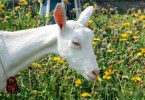Lively Run’s Circle of Life (Part One)
As we are approaching spring we are all getting a little giddy, hoping for more sunlight, warmer weather and colors beyond white, grey and black. We are excited for the first buds on trees, the first migratory birds back with us, the first flowers, and the grass changing color from brown to green!
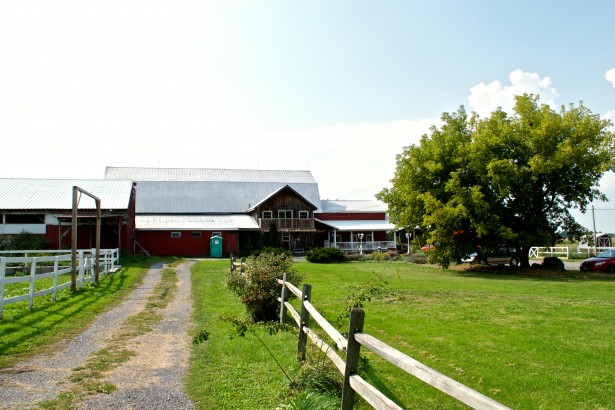
A big part of Spring Fever at Lively Run Dairy is the anticipation for our kids (brand new baby goats) born at some point in April. My name is Suzanne Messmer, co-owner of Lively Run, and I am writing today to explain a bit more about the goat farming cycles.
First things first: Like humans, goats are mammals. The female produces milk after giving birth and nurses her offspring at least until they are mature enough to eat solid foods. As long as there is a demand by a nursing young one, milk is being produced. A dairy farmer essentially takes the role of a nursing baby, by milking the female at least twice a day thereby prolonging the natural nursing for up to 300 days after the goat gives birth. The milk is stored in a chilled tank until it is either picked up by the processor or, in our case, until we make cheese.
Note: Unlike cow dairies, the production cycle of goats is very seasonal. This is a result of the fact that goats are seasonally breed. Cows ovulate regularly all year long and can be bred any time in the year, which leads to the farmer’s ability to have the same milk output all year long. Goats are different, however.
The Rut
Goats go through a breeding season called “the rut”. The female (doe) ovulates only during the rut. The rut starts with the shortening of daylight in August and ends with the lengthening of days in March. Females ovulate every 21 days until they are bred.

In 2014, we celebrated the start of breeding season with our Buck’s Tale event. Our stud buck Austin was decorated with a wreath of flowers and paraded around the barnyard. This event derived from a 660 year old German tradition.
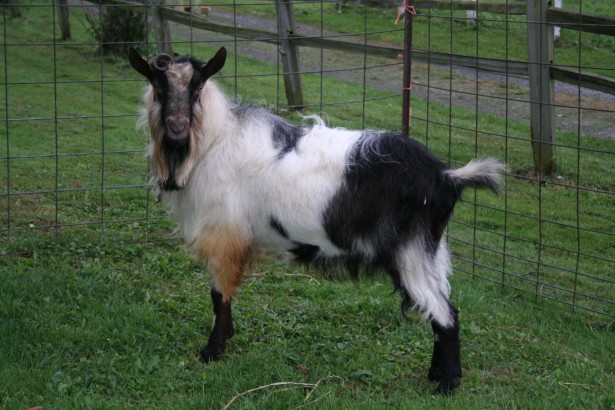
We introduced Austin to the female domain on November 6th last year. He immediately went into action, checking which one of our does was in heat. He does this with a very keen sense of smell. If a doe was ready, he bred her.
Pregnancy
Goats have a gestation period of 5 months. They are milked for about 3 months AFTER BREEDING and then milking is gradually stopped to give the goats a much needed rest of 8 weeks during the winter. In this time, the doe’s diet is changed. They need fewer proteins now that they are not milking. We feed them grass hay with less legumes and calcium. Because of the very cold temperatures in the 2014/2015 winter, we added more calories by feeding corn as well.

A yearling doe (doeling) pregnant for the first time will usually have one baby (called a kid). Does 2-4 year old most likely will have 2 kids. An older doe may have triplets or quadruplets. We even had quintuplets once.
In March, which is about one month away from the birth of our first kids, we start to observe our goats more closely. Are they pregnant? That can be checked with an ultrasound, or by testing the milk for the pregnancy hormone, which is a new technology. This has to be done within the first 3 months after introducing the buck to the herd when the goats are still milking so we can see who is not pregnant and who can still be milked.
Birthing
Birthing in the goat world is called kidding. A doe will show signs of getting ready to kid about 2 weeks before the actual event. Her udder will fill with milk a little more every day in preparation for the new babies. The ligaments around her tail bone will be looser and the birth canal will wide. Shortly before starting labor she may stand by herself quietly, sometimes bending her neck and looking at her own flanks. She looks like she is listening to something!
Eventually the labor pains and contractions will start. The doe may paw the ground in front of her, she may walk around and push. Later on she may lay down on her side and push. Some does are quiet, while others are very loud. Of course, it also depends on whether the kids are presented correctly. Ideally the kid’s front feet will come first, with the top of the nose towards the mother’s backbone. If we see this happening we usually don’t have to help out at all.

Each kid comes out in its own sack of amniotic fluid. The sack may brea before the kid’s head is through the birth canal, or it may still be in the sack when it is all the way born. We always make sure the nostrils of the new babies are cleared immediately because sometimes the mom starts the cleanup of the baby on the wrong end, and the baby can’t breathe.
Good moms start talking to their kids right away. It sounds like a low chuckle. They also lick the baby clean of the sack and mucus. This is like a little massage and invigorates the kids breathing and heartbeat. The kid will make its own most adorable little baby noises. A strong bond is established in these first minutes between mother and kid.
Unfortunately, the mom goes into contractions again right in the middle of this first interaction. Number two and sometimes number three are born and require the same attention! Younger moms are often confused and stressed. Because of this, we often come help clean and rub the little bodies.
Sometimes birthing happens with up to three does at the same time! Does can get confused who is whose baby. Their instinct to lick the wet body three feet over there is very strong. There are also some “supermoms” who kidnap other does’ babies and push the other mom away from her baby.
Trying to keep things straight can tax the farmer, as well. We usually put collars and numbers on kids soon after they are born in order to keep track. When we are aware of a does’ impending labor we frequently check her during the night hours, as well.
Kids
Watching a birth is amazing and miraculous. When we see these things, we realize the tremendous responsibility God has given to us for our livestock and in our environment. These animals provide a living for us, and in return we want them to have the best possible care! The Lively Run family gets attached to our does and kids.
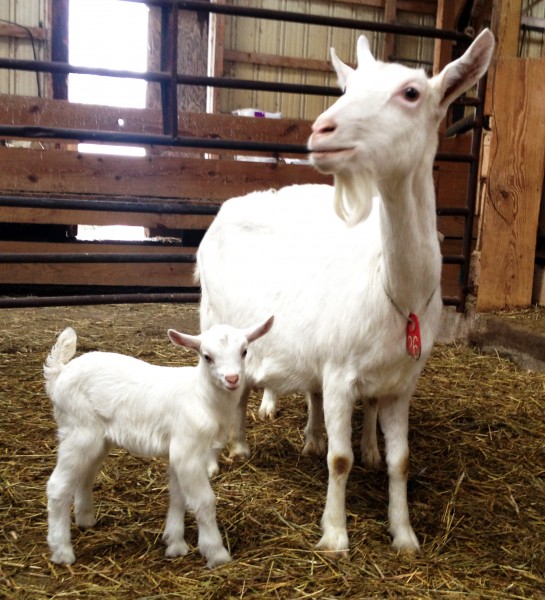
Kids are amazingly strong. Within 30 minutes they stand up and are searching for the teat to get their first drink of their mother’s milk. This milk is called colostrum. It is super thick, yellow and full of concentrated nutrition, as well as antibodies to strengthen the new earthling’s immune system. The mother will guide her kids to her teats by gently pushing them between her front legs towards the udder. In cold weather, this first drink has to happen really quickly after birth, or the baby will not live.
At Lively Run, we to start our kidding in the middle of April when the temperatures are moderate. Our barn is an old cow dairy, with plenty of ventilation to accommodate large cows. Consequently it is a little colder than optimum for newborn goat babies in January through February. Starting our kidding later allows for warmer weather for the newborns.
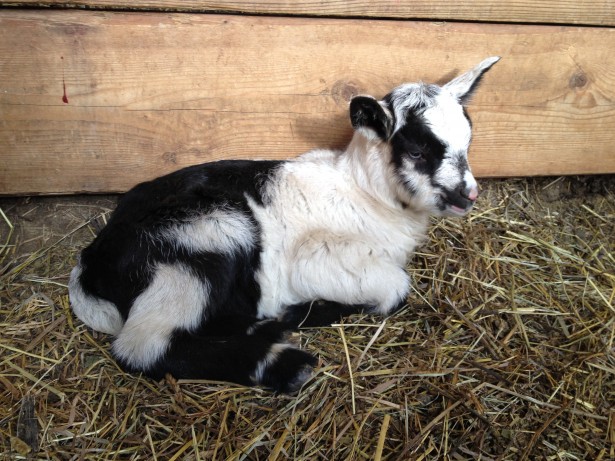
We will celebrate our new kids on mother’s day weekend this year with our Just KIDDing event.
In my next blog, Lively Run’s Circle of Life (Part 2), I will address how we raise our adorable herd of baby goats and what you can do and see when you come here on May 9 and 10 for Just KIDding! Until then: Enjoy spring!
Blog written by Susanne Messmer, co-owner of Lively Run Dairy.


